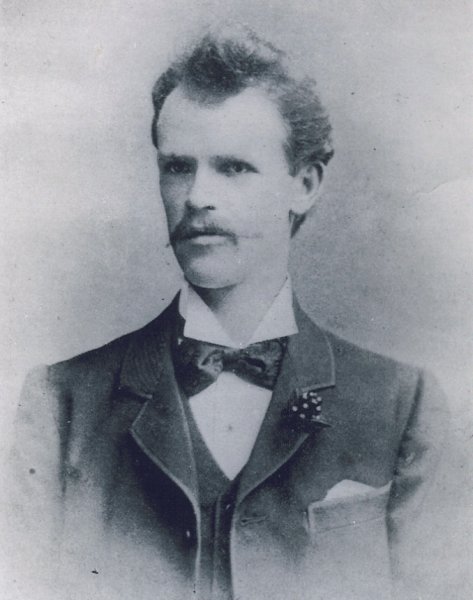Contributed by Sue Lee, whose husband is Henry William Judd's great-grandson

HENRY WILLIAM JUDD
1865 - 1924
Henry William Judd was born on 27 December 1865, second child and son of Edwin and Ann Judd (nee Allen) in Tingewick, Buckingham, England.
Siblings - Herbert Owen, Annie Louisa, Edwin Allen, Ada Jane, Emily Mary, Richard Thomas, Kate Elizabeth.
Henry belonged to the Church of England and as a young man was very good at cricket and athletics. He belonged to Bicester Cricket Club and in 1889 was presented with a cricket bat with silver plate for making 117 runs in one innings, the first ever century recorded in the village of Tingewick.
Athletics results: On 22 July 1889 (aged 24) with the Bicester Harriers' Amateur Athletics Club he got two firsts - Silver Stick and 100 yards flat race; 2nd in high jump and 3rd in 200 yard hurdles. In another competition, high jump recorded at 4'7", 1st in throwing the cricket ball and 1st in half mile race for Championship of the Harriers' Club.
From a newspaper clipping at the time we learn "as Mr Judd stepped up to receive the silver championship cup offered by this club, the band struck up 'See the conquering hero comes'. Mrs Tubb said she was very pleased to hand the winner the cup, and presumed he knew he must win it three years in succession before it became his actual property."
Henry's first profession was teaching which he began in 1884 when he finished his apprenticeship at Flore Boys School Northamptonshire.
In 1889 he taught at Boys' School, Bicester, Oxon and in 1890 received a Certificate of Proficiency in Phonetic Shorthand from I. Pitman. In 1890 Henry was a Senior Assistant Teacher and had been an apprentice and teacher for about 10 years.
On Saturday 10 January 1891, Henry left England at Plymouth and arrived in Tasmania, Australia on 20 February 1891 aboard the 'SS Aorangi' where he became a teacher at the Model School, Carnarvon (Port Arthur) for a few months.
He brought with him to Hobart testimonials as below:
Jan 1884 testimonial, on expiration of Apprenticeship from Mr S Dawson Head Master Flore Boys' School, Northamptonshire; Jan 1884 Certificate of Religious Knowledge from His Grace the Bishop of Peterborough Oct 1889 from Mr W H Piggott, Head Master Boys' School Bicester Oxon Oct 1889 from Rev J B Kane, Vicar of Bicester Jan 1890 Certificate of Proficiency in Phonetic Shortland from I Pitman, Esq May 1890 Science and Art Departments Certificate, Second Grade Freehand drawing Oct 1890 from the Rt Hon the Earl of Jersey; Rev W H Draper, Middleton Rectory, Bicester Dec 1890 from Bicester Schools Committee; and H Tubb Esq Bankers, Bicester.
While at Port Arthur he saw an advertisement for a position as a reporter so decided to change career and became a Literary Reporter on the Tasmanian News in Hobart.
When Henry arrived, he lived at 214 Melville Street Hobart next door to the Tibballs family. On 4 December 1891 he married Nona Tibballs at St John's Church, Goulbourn Street, West Hobart by Rev. Finnis.
In 1892 Henry transferred to the Mercury and in 1894 was appointed Manager, Mercury, West Coast. This involved moving his family (wife and 2 children) to live in Zeehan at the time a thriving mining centre. Henry became the only photographer on the West Coast. During his time in Zeehan, he was a member of the Mining Museum and wrote a book 'Pictorial Guide to the West Coast.' He also introduced native birds to the Zeehan area. Henry was transferred to Launceston as manager of that branch, and about 1921 returned to Hobart where he was a member of the literary staff of the Mercury.
He was an authority on mining and was a keen photographer and amateur gardener who won prizes for his displays.
He was a member of the Wellington Cricket Club and Vice-President of the Tasmanian District of the Australian Journalist's Association.
Henry and Nona had four children - Jack who died in a car accident aged 42, Nona who died aged 2; Dulcie who lived to nearly 94 and Esme who lived to 95.
Henry visited his parents in Tingewick in 1908 and took photos.
Henry died 23 March 1924.
In Henry JUDD's death notice, mention is made of Mrs and Miss Large - they were Lucy King's sister and mother(?) (Lucy Large nee Read and Marion Large?) Mrs Large later became friendly with Adolphus LEE after their spouses died. Some Larges lived at "The Grange" on Sandy Bay Road.
PORT ARTHUR: This town is Tasmania's number one tourist attraction. It is situated on the Tasman Peninsula 102 Km from Hobart. Established in 1830 when a decision was made to build a penal settlement there. Port Arthur operated as a penal settlement until 1887 when the remaining inmates were transferred to Hobart Gaol. During that period some 12,500 convicts were passed through the system. It was named in honour of Governor Arthur but after the penal system closed down it was changed to Carnarvon. The name change was made in an effort to dispel the bad reputation it had gained as a cruel place, but reverted back to Port Arthur in 1927.